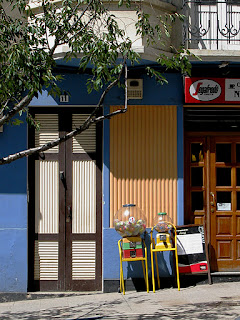Saturday, 28 January 2012
Wednesday, 25 January 2012
Un dibujo para...
...todos los españoles y españolas valientes
que abandonarán su país por explorar nuestro planeta.
Cuando vienen traen color y musica...
...y los alimentos más exquisitos del mundo!
Tuesday, 24 January 2012
Snellegem, a Merovingian Crown Estate.
Today I was one of the volunteers who had to drive schoolchildren to a neighbouring village, where they had to watch a stage play. While don G. and his friends had a good time realizing that cultural life is more then gaming, I payed a visit to a nearby place called Snellegem (Snelle's homestead).
This hamlet is nowadays a forgotten spot in the middle of nowhere, but has a long and dignified history. And a few interesting buildings to illustrate it.
In the 7th century the place became a Crown Estate, the "fiscus Snelleghem", belonging to the Merovingian dynasty, with a major or domesticus who lived on the central fortified farm, named "Ridderhof" or "Oosthof" (Knight's stead or East stead).
Today it's a restaurant and the oldest parts, like the entry gate, are dating back to the 15th century. A part of the rampart ditch is still visible, and the general aspect is that of a typical 17th century farm.
There is also a beautiful little Romanesque church, the Saint-Eligius church, built in 1150.
When the Merovingian king Dagobert I encouraged the christianisation of his kingdom, Saint Eligius of Noyon had -around 630- a wooden church constructed on the Royal Estate. It was dedicated to Saint-Stephen and was replaced during the 12th century by the actual church, with its octagonal tower.
In 1893 a mastodonic neo-Gothic church was built just beside the old one, completely spoiling the scenery. Locals told me that once a village priest wished the ugly thing to be pulled down. I presume he would have had good king Dagobert's support!
View Larger Map
Monday, 23 January 2012
Saturday, 21 January 2012
Wednesday, 18 January 2012
La Iglesia del beguinaje de Brujas.
El Beguinaje principesco " Ten Wijngaerde" (el viñedo) fue fundado en 1244, pero las beguinas vivían allí con anterioridad. El lugar era una pradera fuera de las murallas de la ciudad. Margaretha II de Constantinopla, condesa de Flandes, fundó oficialmente el Beguinaje y el rey Felipe IV de Francia y de Navarra (el Hermoso) fue el patrón y protector del Beguinaje en 1299.
La primera Iglesia reemplazó la Capilla condal que se encontraba en el castillo. La capilla original está todavía en el Burg (fortaleza), próximo a la casa consistorial. Es la parte inferior de la Basilica de la Santa Sangre.
La Iglesia de la Santa Isabel de Hungría, patrona de las beguinas, fue destruida por un incendio en 1584. Reconstruida alrededor de 1600 en estilo gótico, se trata de una iglesia con tres naves y sin crucero que tiene todavía una puerta románica del primer edificio.
Un siglo más tarde se llevó a cabo su hermoso interior barroco.
Viva, my first attempt in writing Spanish! I hope it makes some people happy, there far away in good old Spain.
Visita el foro. Estamos esperando las reacciones iniciales.
Saturday, 14 January 2012
The legend of the honey princess, part I.
He stayed together with some other brothers on an old Roman estate, donated to their monastic order by a local widow, who wished the place to become a monastry.
They spent their days -as good monks do- in prayer and hard labour on the land. The task of maintaining the orchard and vegetable garden was assigned to the young monk, who was a farmer boy. And because of his hard work and dedication the gardens greatly flourished and there was an abundance of vegetables, herbs and fruits.
And it often happened that local countryfolk passed by and stopped for a while to overlook the orchard and garden, and they admired and praised the work of the gardener.
The humble monk felt very embarrassed with all those compliments bestowed upon him and said that he, simple gardener, was only the Almighty's instrument.
Amongst the many passers-by was sometimes a young girl of great beauty and noble birth.
She belonged to an old family of royal descent, and never went for a walk without her two ladies-in-waiting and an old guard.
Every time the young lady and her little party passed, the monk had to use some effort to keep his vow of chastity in mind, and he turned his face, so no one could see the guilty blush on his cheeks. Alas, what the poor man didn't knew was the horrible destiny of that little princess.
Her forefathers were maybe men of great power, respected and beloved kings. It was all past glory.
The girl's father could only dream of his ancestor's prestige, but all he had inherited was an old palace, a noble title and an empty purse. He was a weak man, lacking the brave character of his ancient and distinguised family.
His only concern was to find funds to keep up an appearance as a nobleman of great worth. As his lovely daughter had no lack of suitors, the old man thought that her beauty could solve the problem.
And he turned her life into a nightmare!
(To be continued)
Thursday, 12 January 2012
The soft French spot in Flanders soul
It's often said that Southern Europe meets Northern Europe in Belgium. Flanders too can be very Nordic, but always with a Mediterranean touch. For centuries, the county of Flanders was (at least the part west of the Schelde river) a fief of the French crown.
Present Flanders is spreaded over three countries; Belgium, France and the Netherlands.
Very cosmopolitan since medieval times, the county was greatly influenced by France, Spain and Italy.
Subscribe to:
Comments (Atom)




















